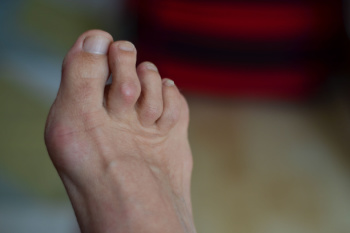
Hammertoe occurs when one of the small toes becomes bent at the middle joint, causing it to point downward instead of lying flat. This deformity often begins as a mild imbalance and becomes more rigid over time. It can be painful and make wearing shoes difficult. The most common cause is an imbalance in the muscles and tendons that support the toe. Wearing tight or narrow shoes, especially those with high heels, can force the toes into an unnatural position. Over time, this leads to the joint stiffening in that shape. Other causes include foot structure inherited from family, past injuries, and certain conditions such as arthritis or nerve damage. Early recognition is important to prevent the deformity from worsening. If you notice changes in the shape of a toe or experience pain or corns, an evaluation by a podiatrist is suggested.
Hammertoes can be a painful condition to live with. For more information, contact Dr. Paul Drucker of NYC Foot Care, PC. Our doctor will answer any of your foot- and ankle-related questions.
Hammertoe
Hammertoe is a foot deformity that occurs due to an imbalance in the muscles, tendons, or ligaments that normally hold the toe straight. It can be caused by the type of shoes you wear, your foot structure, trauma, and certain disease processes.
Symptoms
- Painful and/or difficult toe movement
- Swelling
- Joint stiffness
- Calluses/Corns
- Physical deformity
Risk Factors
- Age – The risk of hammertoe increases with age
- Sex – Women are more likely to have hammertoe compared to men
- Toe Length – You are more likely to develop hammertoe if your second toe is longer than your big toe
- Certain Diseases – Arthritis and diabetes may make you more likely to develop hammertoe
Treatment
If you have hammertoe, you should change into a more comfortable shoe that provides enough room for your toes. Exercises such as picking up marbles may strengthen and stretch your toe muscles. Nevertheless, it is important to seek assistance from a podiatrist in order to determine the severity of your hammertoe and see which treatment option will work best for you.
If you have any questions, please feel free to contact our offices located in 70th Street Manhattan, 60th Street Manhattan, Jamaica, Queens, Plainview, NY and Fair Lawn, NJ . We offer the newest diagnostic and treatment technologies for all your foot care needs.
